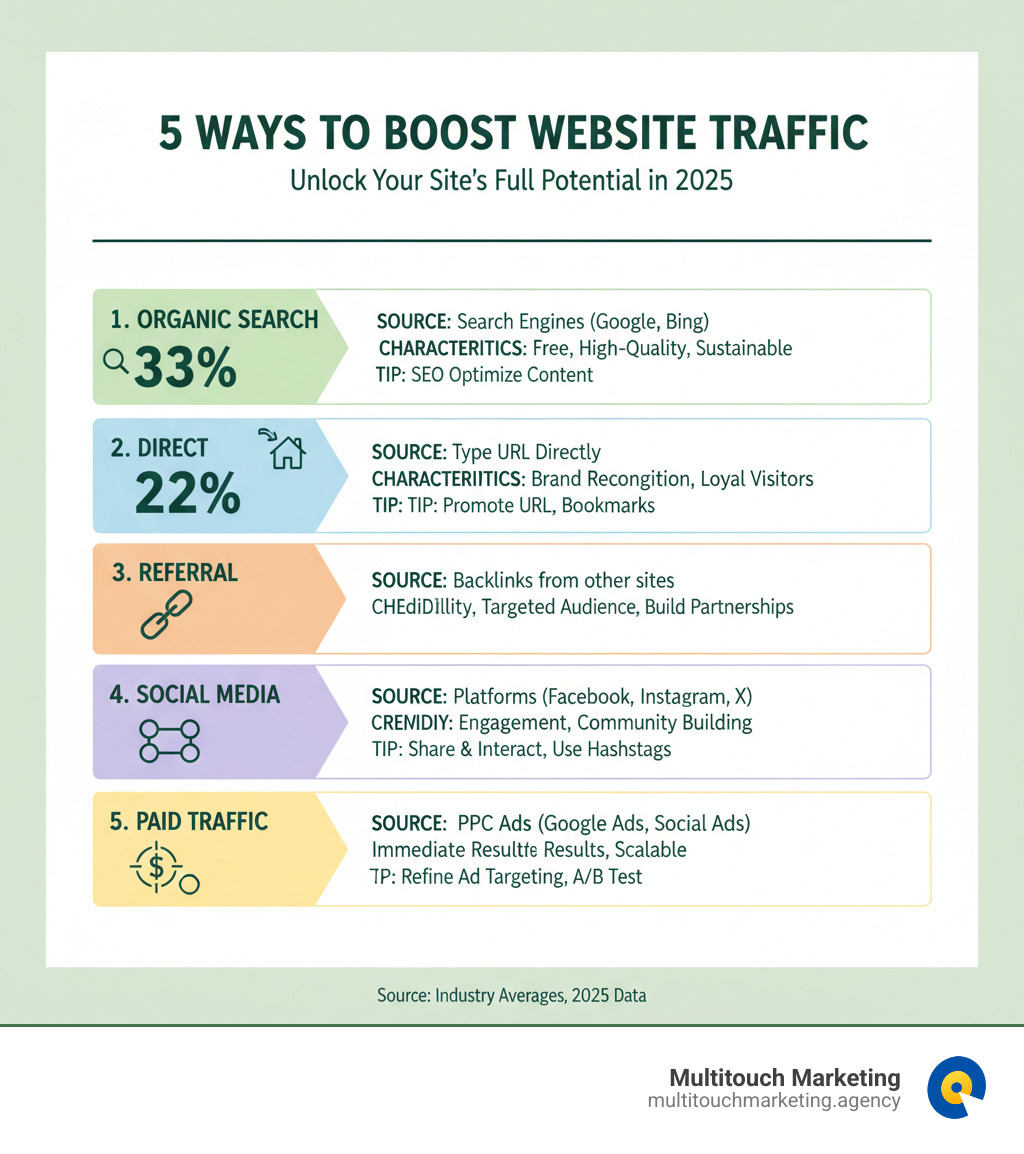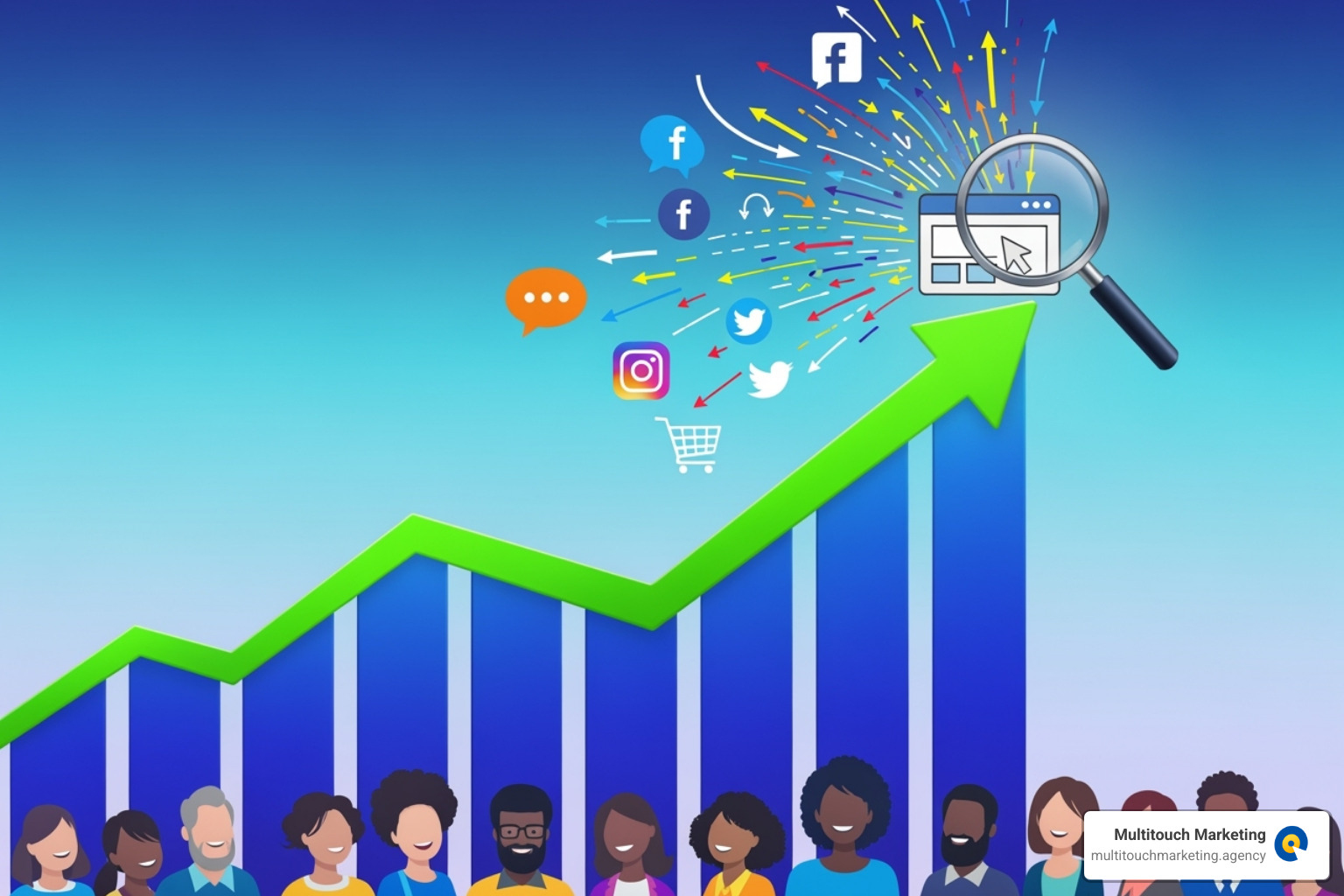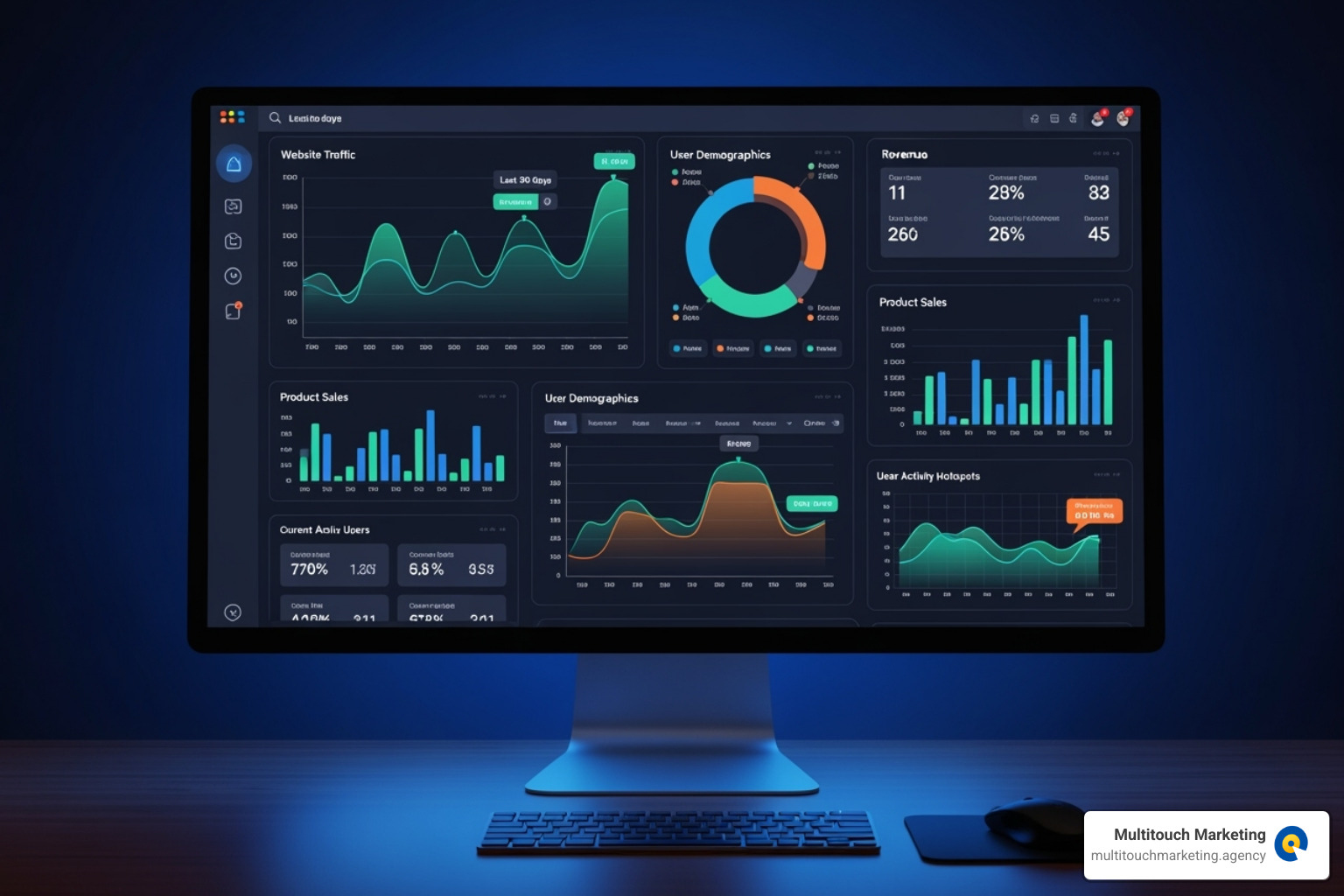Why Website Traffic is the Lifeblood of Your Business
Increase website traffic is a top challenge for business owners. Without visitors, you can’t generate leads, make sales, or grow your business online. This guide covers proven strategies to get more eyes on your website.
Quick Ways to Increase Website Traffic:
- Search Engine Optimization (SEO) to rank higher in Google.
- Valuable Content like blog posts and videos that solve problems.
- Social Media to share content and engage your audience.
- Quality Backlinks from other reputable websites.
- Paid Advertising (PPC) for immediate, targeted traffic.
- Email Marketing to drive repeat visits.
Website traffic isn’t just about numbers; it’s about connecting with potential customers. Understanding traffic types is crucial: Organic (search engines), Direct (typing your URL), Referral (links from other sites), Social (social media), and Paid (ads).
Proven strategies deliver real results. For example, businesses that blog get 55% more visitors, and email marketing can yield an ROI of $36 for every $1 spent.
I’m Milton Brown, and since 2008, I’ve helped businesses increase website traffic through strategic digital marketing. My expertise in paid media management, SEO, and analytics has helped organizations across various sectors boost their online visibility and achieve measurable results.
The Foundation: SEO and Content Marketing
This section covers how to build a strong base to attract visitors organically through search engines and valuable content.
Master On-Page SEO to Increase Website Traffic
Search Engine Optimization (SEO) is the process of getting pages to rank higher in search engines like Google. Since the first page captures 71% of search traffic clicks, ranking well is essential to increase website traffic.
Start with keyword research to understand the phrases your audience uses. Tools like Google Keyword Planner can help you find terms with good search volume. Don’t ignore long-tail keywords (longer, specific phrases like “best vegan protein powder for runners”). They often have higher user intent and less competition, making up 70% of all online searches.
Once you have keywords, optimize your on-page elements:
- Meta titles: Your clickable headline in search results. Keep it under 60 characters and include your primary keyword near the front.
- Meta descriptions: The summary below the title. Write a compelling, unique description of around 155 characters that includes your keyword.
- Header tags (H1, H2, H3): Structure your content with clear headings. Your H1 should have the primary keyword, with related keywords in H2s and H3s.
- Internal linking: Link to other relevant pages on your site within your content. This distributes authority and helps search engines understand your site structure. We use tools like the Link Assistant tool inside AIOSEO Pro to manage this.
Beyond keywords, focus on user experience (UX) and Google’s E-E-A-T guidelines (Experience, Expertise, Authoritativeness, Trustworthiness). Creating content that demonstrates genuine expertise builds trust and is favored by Google. Learn More on E-E-A-T.
Finally, optimize for AI Overviews, the summarized answers at the top of Google’s results. To increase your chances of being featured, structure content with clear headings, use lists, and directly answer common questions. For a deeper dive, see our SEO Optimization Tips.
Create High-Value Content That Attracts and Engages
A strong content marketing strategy is fundamental to organically increase website traffic.
- Business blogging: Businesses that blog get 55% more website visitors and 97% more links. Marketers with blogs are also 13 times more likely to see positive ROI. Your blog should answer your audience’s questions and solve their problems.
- Video content: With YouTube being a massive search engine (over 2.7 billion active users), creating educational videos, tutorials, or product reviews can drive significant traffic.
- Podcasts: Make audio content accessible with transcripts and summaries, which can be repurposed as blog posts. Link back to your site in the show notes.
- Evergreen content: Create timeless guides and resources that remain relevant long after publication.
- Compelling headlines: A great headline can drive 500% more traffic. Use numbers, power words, and create intrigue.
Guest blogging on other reputable sites in your industry is another great way to reach new audiences and earn valuable backlinks.
Here are some content ideas to get you started:
- In-depth guides and tutorials
- Case studies and expert interviews
- Infographics and visual data
- “How-to” articles and product comparisons
- Industry news and analysis
- Lists (e.g., “Top 10 Tools for X”)
For more insights, explore our guide on How SEO Pushes Business Growth.
Ensure Your Site is Technically Sound
Technical SEO ensures search engines can easily crawl, understand, and index your site.
- Website speed: Slow sites frustrate users and hurt rankings. Use Google’s Core Web Vitals to measure speed. Optimize images and leverage browser caching to improve load times.
- Mobile-friendliness: With mobile traffic surpassing desktop and mobile e-commerce sales growing, your website must be responsive. Google primarily uses the mobile version of a site for indexing. Ensure your site has a Responsive Web Design and is easy to steer on small screens.
- Site architecture: A logical site structure helps users and search engines find content easily.
- Schema markup: This structured data helps search engines understand your content (e.g., products, reviews), which can lead to rich results in search listings. Use Google’s structured data testing tool to check your implementation.
Regularly check your site’s technical health with Google Search Console, a free tool that provides data on performance, crawl errors, and more.
Amplifying Your Reach: Off-Page and Social Strategies
This section focuses on promoting your content and building authority beyond your own website.
Build Authority with Backlinks and Community Engagement
Your website’s authority is built on trust and recognition from across the web. Backlinks—links from other websites to yours—act as digital endorsements. Companies that blog get 97% more links, which boosts Domain Authority and search rankings.
Guest posting on reputable industry blogs is an effective way to earn backlinks and showcase your expertise to new audiences. Another tactic is broken link building, where you find broken links on other sites and suggest your content as a replacement.
Don’t overlook online community engagement. Participating in forums can naturally increase website traffic while building genuine relationships.
- Reddit has thousands of niche communities (subreddits). Provide genuine value first; users can spot self-promotion easily.
- Quora is great for establishing expertise by answering questions. You can link to your site when it provides a genuinely helpful resource.
- Facebook Groups often have highly engaged members who trust recommendations from fellow participants.
Authenticity is key in all community engagement. For more on this approach, see Why Social Media Marketing is Necessary.
Leverage Social Media to Drive Targeted Visitors
Social media is a powerful traffic-driving machine. A 2024 survey found that 73% of shoppers find products on social media, with 18% visiting the retailer’s website after the finding.
Content promotion requires more than just posting links. Use compelling captions to spark curiosity and conversation. Create platform-specific content that performs better than one-size-fits-all posts. For example, Twitter is for quick insights, Instagram for visuals, and YouTube Shorts for quick tips.
Your hashtag strategy helps users find your content. Research and use a mix of popular and niche hashtags. Add social sharing buttons to your website to make it easy for readers to share your content.
Engaging with followers by responding to comments and messages builds a loyal community. This creates a ripple effect, as 46% of consumers make purchases based on word-of-mouth recommendations. For more strategies, explore how to Make Your Business Stand Out with Social Media.
Use Email Marketing for Repeat Traffic
Email marketing provides direct access to an interested audience and boasts an average ROI of $36 for every $1 spent, making it a cost-effective way to increase website traffic.
Building an email list starts with offering value. Use lead magnets like guides, discounts, or checklists to entice sign-ups. Your newsletters should feel personal and helpful, sharing your latest content and exclusive insights with clear calls-to-action.
Segmentation and personalization make email campaigns more effective. Group subscribers based on their interests or purchase history to send more relevant content.
Always follow CAN-SPAM compliance guidelines to build trust. This includes providing an easy way to unsubscribe and clearly identifying yourself. For detailed compliance information, review the CAN-SPAM rules.
Paid Strategies to Increase Website Traffic
This section explains how to use paid advertising for immediate and scalable traffic growth.
Accelerate Growth with PPC Advertising
When you need immediate results, Pay-Per-Click (PPC) advertising is the answer. While SEO builds long-term growth, PPC is like a traffic faucet you can turn on to increase website traffic within hours. You pay a fee each time someone clicks your ad, essentially buying visits from an interested audience.
Google Ads is the dominant PPC platform, as Google holds 79.1% of the desktop search market. You can run various ad types:
- Search ads appear at the top of Google results for your keywords.
- Display ads show up on websites across Google’s network.
- Shopping ads showcase your products with images and prices.
The PPC ROI is compelling. Most businesses see a $2 return for every $1 spent, with some claims as high as $8 for every dollar invested.
Strategic keyword bidding is crucial. Focus on high-intent keywords that signal a readiness to buy. Use negative keywords to prevent your ads from showing for irrelevant searches (e.g., blocking “free” if you sell premium services).
At Multitouch Marketing, we help businesses in Raleigh, Durham, and Chapel Hill steer paid advertising. PPC requires constant monitoring and optimization to maximize results. Aligning your campaigns with clear goals—whether generating leads, driving sales, or increasing brand awareness—is key. For more insights, read our guide on Why PPC Advertising is Beneficial in Business.
Target Your Audience with Paid Social Media Campaigns
Social media advertising allows for laser-precise targeting. Instead of casting a wide net, you can reach your ideal customers directly.
- Facebook Ads and Instagram Ads are powerful for B2C businesses, with deep demographic and interest-based targeting.
- LinkedIn Ads excel for B2B, allowing you to target by job title, company size, and industry.
The real power lies in targeting options. You can reach people based on age, location, interests, online behaviors, and more. Retargeting is especially effective, as it targets people who have already visited your website but didn’t convert, leading to higher conversion rates.
Your ad copy must be compelling enough to stop the scroll and include a strong call-to-action (CTA). A good CTA can increase click-through rates by 2.8%. Including customer testimonials is also effective, as 93% of customers say online reviews influence their buying decisions.
Paid social provides an immediate feedback loop, allowing you to test and refine your campaigns in real-time. Success requires strategic planning and ongoing optimization. For detailed strategies, explore our Tips for Successful Paid Social Media Campaigns.
Measuring Success and Advanced Tactics
This section covers how to track your results and explore less common but effective traffic-driving methods.
Use Analytics to Measure and Refine Your Strategy
You can’t improve what you don’t measure. Analytics tools like the free Google Analytics provide clear, actionable insights into your website’s performance. Without tracking, efforts to increase website traffic are just guesswork.
- Track traffic sources to understand where your visitors come from (e.g., organic search, social media, paid ads). This helps you focus on what’s working.
- Analyze behavioral metrics like bounce rate and time on page to gauge user engagement. A high bounce rate might signal a need to improve your content or user experience.
- Set up conversion goals to track valuable actions like newsletter sign-ups or purchases. This helps you identify which traffic sources deliver the most valuable visitors.
- Identify top-performing content to create a blueprint for future success. Give your audience more of what they love.
The ultimate goal is measuring ROI by connecting your traffic-driving efforts to actual business results.
Explore Advanced Strategies to Stand Out
Go beyond the basics with these advanced tactics to increase website traffic.
- Host webinars: Showcase your expertise, generate leads, and drive traffic. You can repurpose webinar content into blog posts and social media snippets for long-lasting value.
- Create free tools: A useful calculator, template, or generator can become a bookmark-worthy resource that attracts repeat visitors and earns backlinks.
- Leverage local SEO: For local businesses, optimizing your Google Business Profile is crucial. It’s your digital storefront in local search and Google Maps. Complete your profile with accurate info, photos, and encourage customer reviews. Focus on location-specific keywords like “digital marketing agency Raleigh.” We can help you Generate Organic Visits for Google Business Profile and capture more local customers.
- Use content syndication: Republish your best articles on platforms like Medium or LinkedIn Pulse to reach new audiences. Always include a link back to your original content to drive referral traffic.
Frequently Asked Questions about Increasing Website Traffic
How can I increase website traffic for free?
You can increase traffic without a large budget by focusing on strategies that require time and effort. Start with on-page and technical SEO to build a strong foundation. Consistently publish high-quality content like blog posts and videos that solve problems for your audience. Build backlinks by guest posting on other sites and creating share-worthy content. Finally, engage with your community on social media and in online forums like Reddit and Quora by being genuinely helpful.
How long does it take to see results from SEO?
Patience is key with SEO. While paid ads offer immediate traffic, SEO is a long-term strategy. You can typically expect to see noticeable improvements in organic traffic within 3 to 6 months of consistent effort. Factors like your site’s existing authority, industry competition, and the quality of your work will influence the timeline. Think of it as a marathon, not a sprint, that builds sustainable, cost-effective traffic over time.
What’s the difference between driving traffic for e-commerce vs. content sites?
While the goal is to increase website traffic, the approach differs. E-commerce sites focus on driving sales-ready traffic using transactional keywords (e.g., “buy running shoes online”) and product-focused ads. The customer journey is often short and direct. Content-based websites (like blogs or news sites) attract visitors with informational keywords (e.g., “how to train for a marathon”). Their goal is to build an audience and authority over time, often monetizing through ads, affiliate links, or eventually selling related products.
Conclusion
Driving traffic to your website requires patience, the right tools, and a mix of different strategies. There’s no magic bullet, but combining organic strategies like SEO and content with paid channels like PPC creates the most sustainable and effective results.
Consistency is key. Whether you’re publishing blog posts, engaging on social media, or optimizing ad campaigns, regular effort builds trust with your audience and search engines.
Make sure you’re analyzing your results with tools like Google Analytics. Understanding what drives valuable traffic allows you to refine your strategy and adapt your approach based on data. Every business is unique, so find the right mix of tactics for your goals.
At Multitouch Marketing, we help businesses steer the complexities of digital marketing, from mastering PPC campaigns to building long-term organic growth.
If you’re a local business ready to boost your visibility, learn more about our Local SEO services in Raleigh and find out how we can help you increase website traffic in your community.





